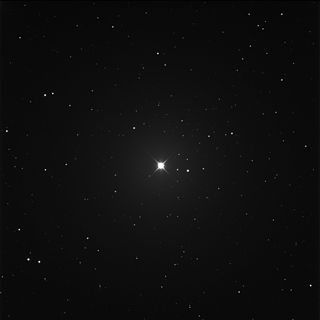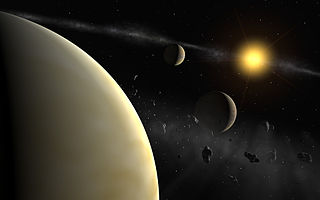
61 Virginis is the Flamsteed designation of a G-type main-sequence star (G7V) slightly less massive than the Sun, located 27.8 light-years away in the constellation of Virgo. The composition of this star is nearly identical to the Sun.

Gliese 876 d is an exoplanet 15.2 light-years away in the constellation of Aquarius. The planet was the third planet discovered orbiting the red dwarf Gliese 876, and is the innermost planet in the system. It was the lowest-mass known exoplanet apart from the pulsar planets orbiting PSR B1257+12 at the time of its discovery. Due to its low mass, it can be categorized as a super-Earth.

HD 69830 d is an exoplanet likely orbiting within the habitable zone of the star HD 69830, the outermost of three such planets discovered in the system. It is located approximately 40.7 light-years (12.49 parsecs, or 3.8505×1014 km) from Earth in the constellation of Puppis. The exoplanet was found by using the radial velocity method, from radial-velocity measurements via observation of Doppler shifts in the spectrum of the planet's parent star.
HD 164922 b is an exoplanet orbiting the star HD 164922 about 72 light-years from Earth in the constellation Hercules. Its inclination is not known, and its true mass may be significantly greater than the radial velocity lower limit of 0.36 Jupiter masses. The planet also has a low eccentricity, unlike most other long period extrasolar planets – 0.05 – about the same as Jupiter and Saturn in the Solar System. The exoplanet was found by using the radial velocity method, from radial-velocity measurements via observation of Doppler shifts in the spectrum of the planet's parent star.
TW Hydrae b is a likely extrasolar planet orbiting the young T Tauri star TW Hydrae approximately 176 light-years (54 parsecs, or nearly 1.665×1016 km) away in the constellation of Hydra. It is likely a Neptune-like planet orbiting at a distance of nearly 22 AU from its star.
This page describes exoplanet orbital and physical parameters.
HD 40307 d is an extrasolar planet orbiting the star HD 40307, located 42 light-years from Earth in the direction of the southern constellation Pictor. The planet was discovered by the radial velocity method, using the HARPS apparatus in June 2008. It is the most massive of the six proposed planets in the system. The planet is of interest as this star has relatively low metallicity, supporting a hypothesis that different metallicities in protostars determine what kind of planets they will form.
HD 154672 is a yellow subgiant. It is about 65 parsecs away from the Sun that is larger than, but of a similar mass to, the Sun. However, HD 154672 is much older. The star is very metal-rich, which is one of the reasons why it was targeted for a planet search by the N2K Consortium, which discovered the gas giant planet HD 154672 b using Doppler Spectroscopy; the discovery was reported in October 2008. The N2K collaboration chose HD 154672 primarily because it aimed to discover the correlation between a star's metallicity and the mass of orbiting planets.
HD 154672 b is an extrasolar planet located approximately 210 light-years away in the constellation of Ara, orbiting the metal-rich and aged star HD 154672. This planet has a minimum mass five times that of Jupiter and orbits at about 60% the distance between the Earth to the Sun. Its orbit is very elliptical, which causes temperatures on the planet to vary significantly as it proceeds along its orbit. This planet was discovered in Las Campanas Observatory on September 5, 2008 using the radial velocity method. Along with HD 205739 b, the planets were the first to be discovered by the N2K Consortium using the Magellan Telescopes.
BD+14 4559 b, named Pirx, is an exoplanet orbiting the K-type main sequence star BD+14 4559 about 161 light-years (49 parsecs, or nearly 1.5×1015 km) from Earth in the constellation Pegasus. It orbits its star within the habitable zone at a distance of 0.777 AU, close to that of Venus, but its star is less energetic, thus its habitable zone is closer to it than Earth. The exoplanet was found by using the radial velocity method, from radial-velocity measurements via observation of Doppler shifts in the spectrum of the planet's parent star.
61 Virginis c is an exoplanet orbiting the 5th apparent-magnitude G-type main-sequence star 61 Virginis in the constellation Virgo. 61 Virginis c has a minimum mass of 18.2 times that of Earth and orbits one-fifth the distance to the star as Earth orbits the Sun, at a precise distance of 0.2175 AU with an eccentricity of 0.14. This planet would most likely be a gas giant like Uranus and Neptune. This planet was discovered on 14 December 2009 from using a precise radial velocity method taken at Keck and Anglo-Australian Observatories.
GJ 3634 b is a super-Earth exoplanet in the orbit of the nearby red dwarf GJ 3634 at approximately 64.5 light-years in constellation Hydra. The planet is approximately eight times the mass of Earth, and orbits its star every two and a half days at a distance of 0.0287 AU. The planet was the first to be discovered by a group of astronomers searching for exoplanets in the orbit of very-low-mass stars after the team reorganized their strategy, choosing to search for targets that they could also confirm using the transit method. However, a transit event associated with GJ 3634 b was not detected. The planet's discovery was published in Astronomy and Astrophysics on February 8, 2011.
GJ 3634 is a red dwarf star in the Hydra constellation. One planet has been discovered in its orbit, GJ 3634 b. GJ 3634 is under half the mass and size of the Sun, and is estimated to be at least a billion years younger, and lies near to Earth, with a distance of 66.5 light-years. It was targeted by astronomers during an over six-year survey of red dwarfs. The astronomers had recently changed their strategy to search for planets with extremely short orbits so they could narrow down candidates that transited, or crossed in front of, their host stars as seen from the Earth. The super-Earth GJ 3634 b was the first planet discovered using this new strategy. The planet was confirmed using Doppler spectroscopy, or the observation and extrapolation of data from a recorded Doppler effect in the star's light, but later observations found no transiting pattern. The planet was published by its discoverers on February 8, 2011.
Kepler-61b is a super-Earth exoplanet orbiting within parts of the habitable zone of the K-type main-sequence star Kepler-61. It is located about 1,100 light-years from Earth in the constellation of Cygnus. It was discovered in 2013 using the transit method, in which the dimming effect that a planet causes as it crosses in front of its star is measured, by NASA's Kepler spacecraft.

HIP 11915 b is an exoplanet orbiting the solar twin star HIP 11915 about 190 light-years (57 parsecs, or nearly 1.798×1015 km) from Earth in the constellation Cetus. It is notable as the first exoplanet to be discovered with an orbit and mass similar to that of Jupiter (essentially, a "Jupiter analog"), suggesting that its system may be similar to that of the Solar System. It orbits its star at a distance of approximately 4.8 AU. The exoplanet was found by using the radial velocity method, where periodic Doppler shifts of spectral lines of the host star suggest an orbiting object.

HD 219134 b is one of at least five exoplanets orbiting HD 219134, a main-sequence star in the constellation of Cassiopeia. HD 219134 b has a size of about 1.6 R🜨, and a density of 6.4 g/cm3 and orbits at 21.25 light-years away. The exoplanet was initially detected by the instrument HARPS-N of the Italian Telescopio Nazionale Galileo via the radial velocity method and subsequently observed by the Spitzer telescope as transiting in front of its star. The exoplanet has a mass of about 4.5 times that of Earth and orbits its host star every three days. In 2017, it was found that the planet likely hosts an atmosphere.
HD 219134 d, also known as HR 8832 d, is an exoplanet orbiting around the K-type star HD 219134 in the constellation of Cassiopeia. It has a minimum mass over 16 times that of Earth, indicating that it is likely a Hot Neptune. The exoplanet was initially detected by the instrument HARPS-N of the Italian Telescopio Nazionale Galileo via the radial velocity method. Unlike HD 219134 b and HD 219134 c it was not observed by the Spitzer Space Telescope and thus its radius and density are unknown. Only a minimum possible radius can be given.
HD 240237 b is a super-Jupiter exoplanet orbiting the K-type giant star HD 240237 about 4,900 light-years (1,500 parsecs, or nearly 4.6×1016 km) away from Earth in the constellation Cassiopeia. It orbits outside of the habitable zone of its star at a distance of 1.9 AU. The exoplanet was found by using the radial velocity method, from radial-velocity measurements via observation of Doppler shifts in the spectrum of the planet's parent star. The planet has a mildly eccentric orbit.
HD 164922 c is an exoplanet orbiting the star HD 164922 about 72 light-years from Earth in the constellation Hercules. The exoplanet was found by using the radial velocity method, from radial-velocity measurements via observation of Doppler shifts in the spectrum of the planet's parent star.
38 Virginis b is a super-Jupiter exoplanet orbiting within the habitable zone of the star 38 Virginis about 108.5 light-years from Earth in the constellation Virgo. The exoplanet was found by using the radial velocity method, from radial-velocity measurements via observation of Doppler shifts in the spectrum of the planet's parent star.





